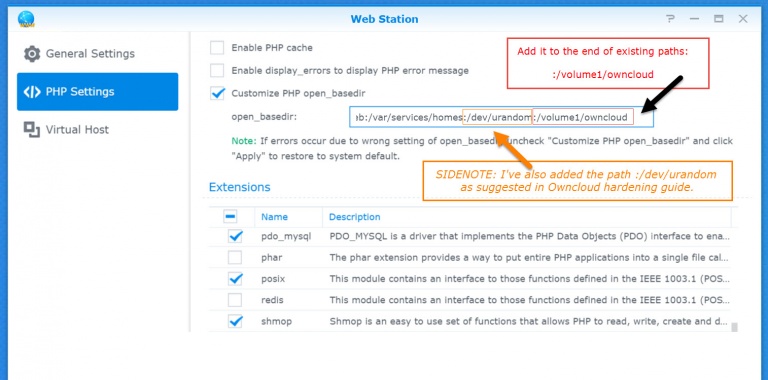

There's no way to make Linux programs work from an NTFS volume. I can see the symlinks ( /var/But that doesn't really matter: even if you manage to craft permissions to make Owncloud happy, you'll soon see that PHP or Apache will complain. It's not clear what your immediate problem is. Check the tutorial you're using and note that the external drive is formatted as EXT4 there. Relying on mount permissions (set in /etc/fstab) will not work in general case: mount sets the same permissions for all files on a volume, so a program which wants its config file to have special permissions or ownership will fail. If you want to make your USB stick fully usable by Linux programs, you should really consider formatting it as EXT2/3/4 (whichever you prefer), or at least make an EXT2/3/4 partition on it. I'm out of ideas, and Googling around hasn't led me anywhere. rw-r-r- 1 www-data www-data 233 May 30 19:04 version.php Getting started with ownCloud packaged by Bitnami container Prerequisites Docker Engine 1.10. We provide several docker-compose.yml configurations and other guides to run the image directly with docker. rw-r-r- 1 www-data www-data 179 May 30 19:04 index.html Installation Check the container documentation to find all the ways to run this application. Lrwxrwxrwx 1 www-data www-data 22 May 30 19:15 data -> /media/cruzer_usb/data Lrwxrwxrwx 1 www-data www-data 24 May 30 19:16 config -> /media/cruzer_usb/config

I take that to mean that www-data needs to have access to the folder, in which case, my webserver does have access to the config directory: >sudo ls -l /var/www/html/owncloudĭrwxr-xr-x 29 www-data www-data 4096 May 30 19:03 3rdpartyĭrwxr-xr-x 26 www-data www-data 4096 May 30 19:04 apps This can usually be fixed by giving the webserver write access to the config directory. I've made a symbolic link from my data and config folders to a USB stick mounted at /media/cruzer_usb (as per the link), and everything works, except when I go to I am told: Php7.2-intl php7.2-readline php7.I'm trying to set ownCloud up on my Pi (following this). Php7.2-imap php7.2-mysql php7.2-mbstring \
#Bitnami owncloud config.php location install
Sudo apt-get install -y nginx php7.2-fpm php7.2-cli \ Sudo add-apt-repository -y ppa:nginx/development Sudo add-apt-repository -y ppa:ondrej/php Here's what I did to create this scenario and test out the Nginx configuration: # Ubuntu 16.04 Server That sends our correctly-parsed script file path to PHP-FPM. server block, where it's parsed correctly! The index.php file is in the correct location on the disk, and the included nf configurations parse out the foo route from the rest of the URI as normal (via fastcgi_split_path_info, if you were curious).ĭon't forget the needed change to the SCRIPT_FILENAME FastCGI parameter explained above as well.

Here's the working configuration to have two Laravel apps working, where one application exists in a subdirectory of another. The example PHP applications are Laravel 5.5. The server is Ubuntu 16.04,, we install Nginx 1.13 and PHP 7.2. This feels like it should be simple, but it turns out to be more complex and fraught with confusing Nginx configurations! To make matter worse (or, perhaps, to illustrate this point), a quick Google search reveals a TON of confusing, non-working examples.
#Bitnami owncloud config.php location how to
In this video, we work through how to put your PHP application in a subdirectory of another site.įor example, we may have an application running at but need a second application running at /blog.


 0 kommentar(er)
0 kommentar(er)
